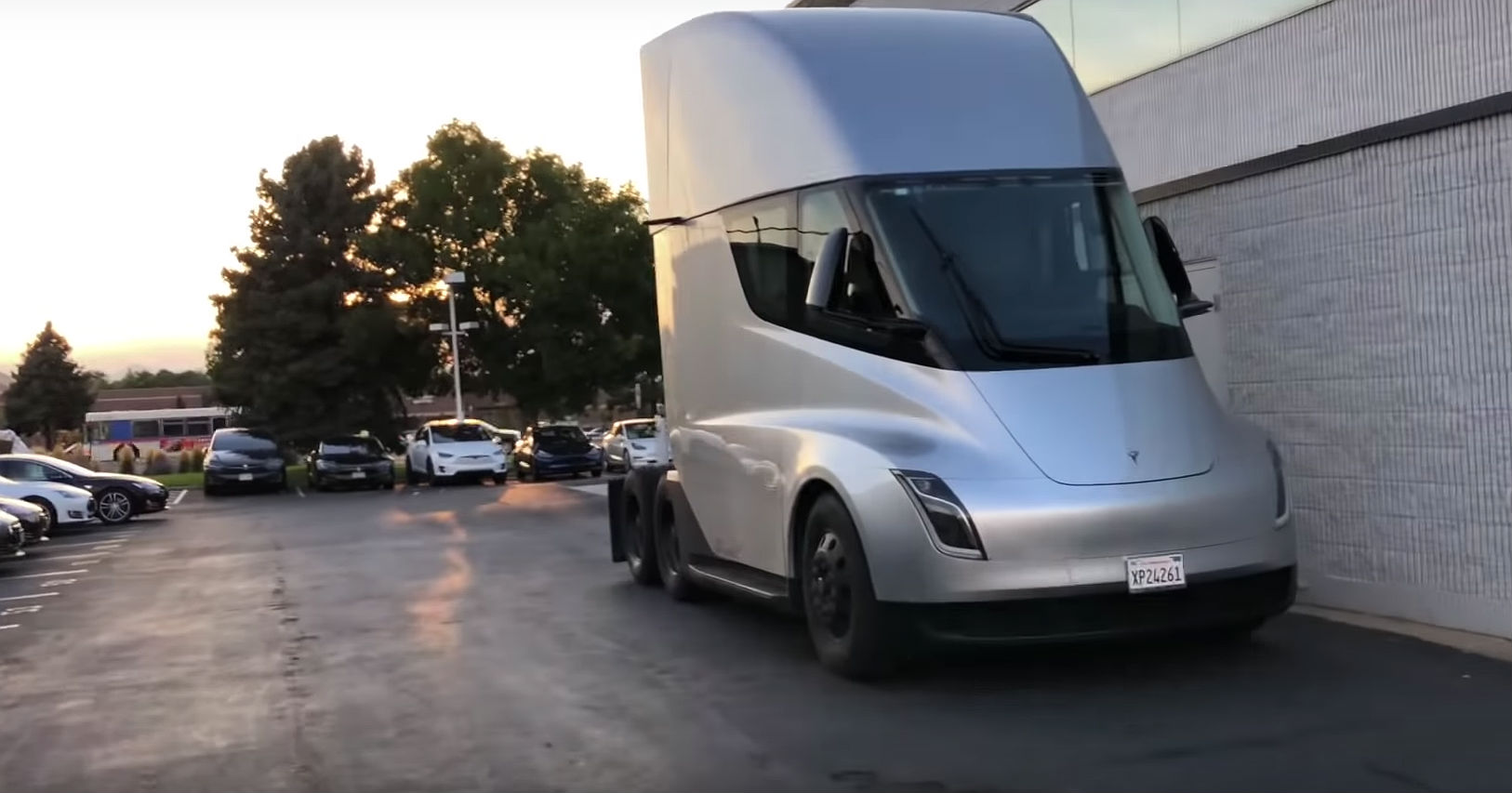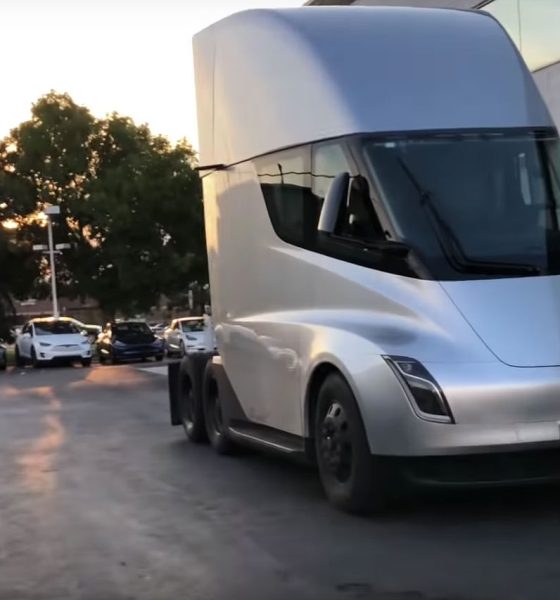

News
Tesla Semi prototype’s multiple camera setup highlighted in new video
Tesla expects to start production of the electric Semi truck sometime in 2019, but the company is already getting busy doing some real-world tests using a hand-built prototype version of the vehicle. The Tesla Semi prototype has been spotted in multiple states recently, and when it stopped by CO, it was filmed extensively by Tesla enthusiasts.
The Semi was initially sighted as it was charging at the Brush, CO Supercharger. During its stop, Model 3 owner and recording engineer Erik J. Martin was able to ask questions to the team of engineers who were accompanying the truck as it traveled across the United States. Among the most notable aspects of the vehicle that were related to Martin were its 300-mile range, its lack of a sleeper cabin, its carbon fiber body, and its unique 26-camera system.
These cameras were filmed by Tesla owner-enthusiast Sean Mitchell, who was able to take a very close look at the electric long-hauler while it was parked at the company’s facility in Denver, CO. Mitchell’s video revealed the unique placement of some of the vehicle’s cameras, including those that were installed at the truck’s side mirrors, as well as an array of at least six cameras that were mounted at the back of the truck. The vehicle also featured Tesla’s trademark three-camera array at the front, which would likely be utilized for the vehicle’s semi-autonomous functions.
Tesla is sparing no expense with the Semi, and the vehicle is designed to be one of the most technologically advanced trucks on the road. Since it’s planned for a 2019 release, Tesla is likely ensuring that the vehicle is future-proof as well, which could explain why the company opted to install a very generous number of cameras in the prototype. Cameras would play a significant role in Tesla’s vision for the Semi, particularly since the vehicle was unveiled with a side-mirror-less design. “Convoy Mode,” a key feature that allows the trucks to semi-autonomously draft in close proximity with each other, would likely utilize input from multiple cameras as well.
In a follow-up video on his YouTube channel about his encounter with the vehicle, Erik J. Martin noted that he was informed that the Semi’s production version would likely have fewer cameras. This would be a sensible decision on Tesla’s part, especially since some of the cameras currently in the prototype appear to be redundancies for other cameras on the vehicle.
Tesla is now on full throttle in terms of testing the Semi on actual roads, and the prototype, which has been going around the United States for months now, has likely gathered a healthy amount of mileage. This could be seen when the long-hauler was filmed in Denver, CO, as signs of wear from thousands of miles worth of traveling were evident in the vehicle. These battle scars from the road make the Semi even more impressive, as it shows that Tesla is ensuring that the electric truck will be ready for deployment when it reaches the market.
Elon Musk announced last November that the Semi would enter production sometime in 2019. Such a timeline is hyper-aggressive, and is classic Elon Musk. That said, the fact that the Semi shares several components with the Model 3 such as its electric motors, door handles, air vents, and 15″ touchscreens would likely make the vehicle a little less troublesome to produce at scale than the midsize electric sedan. Thus, even if the Semi’s actual production ends up starting in “Elon time,” there is a good chance that the electric truck’s deliveries would not see the delays that plagued the company’s previous vehicles like the Model X and the Model 3.
Watch Sean Mitchell’s extensive look at the Tesla Semi in the video below.

News
Tesla China delivery centers look packed as 2025 comes to a close
Needless to say, it appears that Tesla China seems intent on ending 2025 on a strong note.

Tesla’s delivery centers in China seem to be absolutely packed as the final days of 2025 wind down, with photos on social media showing delivery locations being filled wall-to-wall with vehicles waiting for their new owners.
Needless to say, it appears that Tesla China seems intent on ending 2025 on a strong note.
Full delivery center hints at year-end demand surge
A recent image from a Chinese delivery center posted by industry watcher @Tslachan on X revealed rows upon rows of freshly prepared Model Y and Model 3 units, some of which were adorned with red bows and teddy bears. Some customers also seem to be looking over their vehicles with Tesla delivery staff.
The images hint at a strong year-end push to clear inventory and deliver as many vehicles as possible. Interestingly enough, several Model Y L vehicles could be seen in the photos, hinting at the demand for the extended wheelbase-six seat variant of the best-selling all-electric crossover.
Strong demand in China
Consumer demand for the Model Y and Model 3 in China seems to be quite notable. This could be inferred from the estimated delivery dates for the Model 3 and Model Y, which have been extended to February 2026 for several variants. Apart from this, the Model Y and Model 3 also continue to rank well in China’s premium EV segment.
From January to November alone, the Model Y took China’s number one spot in the RMB 200,000-RMB 300,000 segment for electric vehicles, selling 359,463 units. The Model 3 sedan took third place, selling 172,392. This is quite impressive considering that both the Model Y and Model 3 are still priced at a premium compared to some of their rivals, such as the Xiaomi SU7 and YU7.
With delivery centers in December being quite busy, it does seem like Tesla China will end the year on a strong note once more.
News
Tesla Giga Berlin draws “red line” over IG Metall union’s 35-hour week demands
Factory manager André Thierig has drawn a “red line” against reducing Giga Berlin’s workweek to 35 hours, while highlighting that Tesla has actually increased its workers’ salaries more substantially than other carmakers in the country.

Tesla Giga Berlin has found itself in a new labor dispute in Germany, where union IG Metall is pushing for adoption of a collective agreement to boost wages and implement changes, such as a 35-hour workweek.
In a comment, Giga Berlin manager André Thierig drew a “red line” against reducing Giga Berlin’s workweek to 35 hours, while highlighting that Tesla has actually increased its workers’ salaries more substantially than other carmakers in the country.
Tesla factory manager’s “red line”
Tesla Germany is expected to hold a works council election in 2026, which André Thierig considers very important. As per the Giga Berlin plant manager, Giga Berlin’s plant expansion plans might be put on hold if the election favors the union. He also spoke against some of the changes that IG Metall is seeking to implement in the factory, like a 35-hour week, as noted in an rbb24 report.
“The discussion about a 35-hour week is a red line for me. We will not cross it,” Theirig said.
“(The election) will determine whether we can continue our successful path in the future in an independent, flexible, and unbureaucratic manner. Personally, I cannot imagine that the decision-makers in the USA will continue to push ahead with the factory expansion if the election results favor IG Metall.”
Giga Berlin’s wage increase
IG Metall district manager Jan Otto told the German news agency DPA that without a collective agreement, Tesla’s wages remain significantly below levels at other German car factories. He noted the company excuses this by referencing its lowest pay grade, but added: “The two lowest pay grades are not even used in car factories.”
In response, Tesla noted that it has raised the wages of Gigafactory Berlin’s workers more than their German competitors. Thierig noted that with a collective agreement, Giga Berlin’s workers would have seen a 2% wage increase this year. But thanks to Tesla not being unionized, Gigafactory Berlin workers were able to receive a 4% increase, as noted in a CarUp report.
“There was a wage increase of 2% this year in the current collective agreement. Because we are in a different economic situation than the industry as a whole, we were able to double the wages – by 4%. Since production started, this corresponds to a wage increase of more than 25% in less than four years,” Thierig stated.
News
Tesla is seeing a lot of momentum from young Koreans in their 20s-30s: report
From January to November, young buyers purchased over 21,000 Teslas, putting it far ahead of fellow imported rivals like BMW and Mercedes-Benz.

Tesla has captured the hearts of South Korea’s 20s-30s demographic, emerging as the group’s top-selling imported car brand in 2025. From January to November, young buyers purchased over 21,000 Teslas, putting it far ahead of fellow imported rivals like BMW and Mercedes-Benz.
Industry experts cited by The Economist attributed this “Tesla frenzy” to fandom culture, where buyers prioritize the brand over traditional car attributes, similar to snapping up the latest iPhone.
Model Y dominates among young buyers
Data from the Korea Imported Automobile Association showed that Tesla sold 21,757 vehicles to the 20s-30s demographic through November, compared to BMW’s 13,666 and Mercedes-Benz’s 6,983. The Model Y led the list overwhelmingly, with variants like the standard and Long Range models topping purchases for both young men and women.
Young men bought around 16,000 Teslas, mostly Model Y (over 15,000 units), followed by Model 3. Young women followed a similar pattern, favoring Model Y (3,888 units) and Model 3 (1,083 units). The Cybertruck saw minimal sales in this group.
The Model Y’s appeal lies in its family-friendly SUV design, 400-500 km range, quick acceleration, and spacious cargo, which is ideal for commuting and leisure. The Model 3, on the other hand, serves as an accessible entry point with lower pricing, which is valuable considering the country’s EV subsidies.
The Tesla boom
Experts described Tesla’s popularity as “fandom culture,” where young buyers embrace the brand despite criticisms from skeptics. Professor Lee Ho-geun called Tesla a “typical early adopter brand,” comparing purchases to iPhones.
Professor Kim Pil-soo noted that young people view Tesla more as a gadget than a car, and they are likely drawn by marketing, subsidies, and perceived value. They also tend to overlook news of numerous recalls, which are mostly over-the-air software updates, and controversies tied to the company.
Tesla’s position as Korea’s top import for 2025 seems secured. As noted by the publication, Tesla’s December sales figures have not been reported yet, but market analysts have suggested that Tesla has all but secured the top spot among the country’s imported cars this year.








